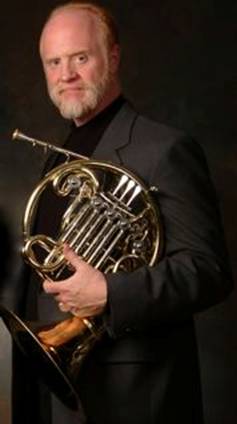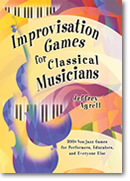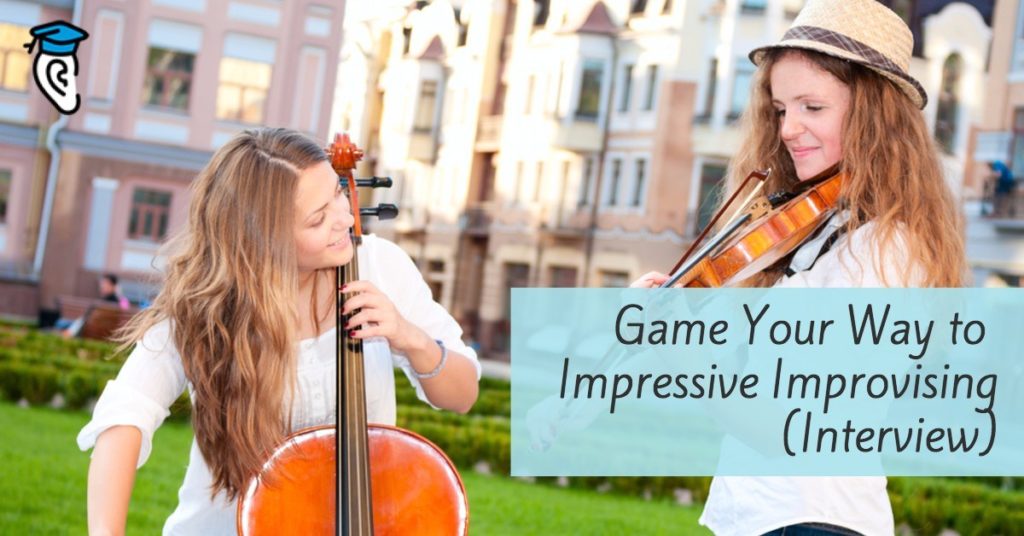If you’ve been avoiding improvising music because you thought it was too complicated or challenging, you’re going to love today’s interview. As part of an impressive career in performing and teaching, Jeffrey Agrell of ImprovInsights.com has written seven books and over one hundred articles about musical improvisation. He specialises in improvisation games: an excellent way for beginners to get started in improvisation.
Read on to discover what’s wrong with the traditional mindset to improvisation, the benefits of approaching it like a game, and some specific suggestions for how you can start easily. Oh, and if you’ve ever thought that improvisation was only relevant for certain instruments or genres, keep in mind that Jeffrey’s primary instrument is the French Horn – and his main genre is classical music!
Hi Jeffrey, and thanks for joining us at EasyEarTraining.com!
Q: Many musicians feel they don’t know how to improvise and so they don’t even try. Do you think that’s a valid concern, that there are core skills you need to learn – or is improvisation simply something you learn by doing?
 Improvisation has suffered from a tragic, door-closing definition – most people think improvisation = jazz and jazz = bebop = MM=220 = Never Going to Happen. That common definition kept me from trying it on the horn (even though I played jazz guitar) for a very long time. If that is the only definition, then 94% (or more) of all classical musicians are never going to do it – jazz is wonderful, but it is not for every player or every instrument.
Improvisation has suffered from a tragic, door-closing definition – most people think improvisation = jazz and jazz = bebop = MM=220 = Never Going to Happen. That common definition kept me from trying it on the horn (even though I played jazz guitar) for a very long time. If that is the only definition, then 94% (or more) of all classical musicians are never going to do it – jazz is wonderful, but it is not for every player or every instrument.
But if you define improvisation without reference to style, simply meaning that the player can choose the note, then new worlds open up.
Every player at every level – including day one – has enough technique to embark on improvisation. This is because improvisation is just like conversation. In a conversation, you take what you know well (the language) and rearrange what you know (words – you usually don’t make up any new words) to express something that you are feeling or want to convey. The best conversationalists are not auctioneers. The best conversationalists are – surprise! – not those with 10,000 hours of technique practice, it is those who are the best listeners.
You don’t need a million words to express a thought. You don’t need a million notes to express yourself in music.
The hardest thing for classical musicians in getting going is Fear – fear of making mistakes. And expecting that they will instantly be able to improvise at the same level immediately that took them many years to achieve with classical playing. They would never expect themselves to be able to be a Chinese auctioneer in a week, but somehow they expect that in music. Classical music vilifies mistakes and thus chokes off the ability and desire of players to enjoy and enrich themselves by making lots of made-up music, exploring their instrument, music, and themselves though improvisation (read William Westney’s The Perfect Wrong Note).
Anybody, from new babies on, can talk and express themselves. Anybody can do the same in music. They just have to adjust their attitude and start playing.
Start with one note. Be safe! Then, gradually, try stuff with that note. Make it longer or shorter. Louder or softer. Repeat it. Try different rhythms. Eventually, another note will suggest itself. Repeat this process – forever.
Listening itself is the most important part of improvisation, just as in conversation. The first thing one has to learn is echoing/imitation. Repeat what you just heard.
Call and Response games are great for this, and can be done with 2 people or with 20. Learn to repeat rhythms first (no pitches). Then short diatonic scale motifs or fragments with mostly stepwise motion. Then gradually increase the range and size of intervals. Try different scale types (major, pentatonic, various minors, etc). Start very simply; gradually progress to more complex material over time.
Go for quantity – lots of imitation first, from simple to more complex material. Stay away from much in the way of harmonic complexity for a good while – that becomes a worry about right note/wrong note, which can choke off efforts because of worrying about mistakes.
Play the simplest tunes by ear (Mary Had a …). Then play them in other keys. All other keys. Then repeat all in minor. Then play with a friend, one on melody, one on harmony. Or countermelody. Or bass line. Or chord roots. Then start “messing around” with the tunes (add ornaments, vary rhythms, dynamics, articulation) – how many different ways can you play Mary Had a Little Lamb?
Stay away from notation. Don’t worry about “doing it right”. Just do it. Do a lot of it. Do it with friends (improv is social). Do it daily, Have fun. When one tune becomes very familiar, start on another one.
 I deliberately and consciously use the term “game” instead of “exercise” or “drill” or some such, thereby automatically forfeiting all respect from academic community experts, because as we all know “music is serious” and one should endure exercises and not have fun – how could doing anything enjoyable possibly be of any use to the serious musician?
I deliberately and consciously use the term “game” instead of “exercise” or “drill” or some such, thereby automatically forfeiting all respect from academic community experts, because as we all know “music is serious” and one should endure exercises and not have fun – how could doing anything enjoyable possibly be of any use to the serious musician?
OK, I’m getting a little snarky, but that is in fact how academia looks at “games” and (horrors) “fun.” But I don’t care. Games are how children learn the world; adults have deluded themselves into thinking that games are frivolous and of no use in learning, but the opposite is true.
The reason so much of classical training consists of dry, tasteless, boring exercises is that it is very easy to teach and to grade that way. Creativity is much more challenging to teach and to grade. So the paradigm is: “play that scale in an octave (or two or three) and I will mark you down for every note that you miss.” Or: “play everything on this page (lessons are always written). Come back next week and I’ll tell you what you missed and then I’ll give the next page or two.” This kind of teaching (convergent thinking) is simple, neat, boring, and not very effective. Easy to grade, to judge.
But turn the same material into some kind of game e.g. “Using the form ABA, invent a piece where A uses C# minor (alter steps 6 and 7 to suit the line ad lib.) to express someone having a very bad day, the B section uses nearly entirely very rhythmic extended techniques but similar rhythms of the A section, then return to A. For extra credit, add a Coda, “C” which is up a step and in major from A” and you can really find out if they know something about technique and about music. Octave scales tell you practically nothing.
Games are all different; there is a near-infinite variety. They need to be chosen by the facilitator (or the players themselves) to suit the group (instruments, level, size of group,room space, time available, etc.).
Participants invariably have different levels of both technique and listening skills, but everyone can play, and play together, regardless of the different levels. Players simply have to listen to what is going on and then decide what they can do to contribute to this.
One danger is that everyone plays too much – once players get over their fears of making mistakes, everyone wants to play all the time. This is almost okay if there are only two players, but in larger groups, facilitators may have to step in to thin out the texture occasionally. For example “Three groups: when I hold up one finger, the bassoon and cello play; two fingers, flute and violins; three fingers, brass. Percussion may play the whole time, but should be subtle in timbre and dynamics. I may point at any time to a soloist outside the group playing; when I do that, the group should switch to accompaniment patterns”.
The biggest danger to any improv group is the player who doesn’t listen, who just plays away without trying to fit with what is going on – chooses his own dynamic (loud, usually), rhythm/meter/pulse, key, style, etc. That’s like having a conversation where one person talks about a completely different subject as everyone else. Listening is the key to all good improvisation. You listen, make a guess as to what to play (or not play), play it, and repeat, adapt, adjust.
”Every improv game is a learning experience to practice both technique and musicianship.”
Every improv game is a learning experience to practice both technique and musicianship. Every game is a challenge to find in the instrument what you hear in your head – all while listening to others.

Oh, boy…. impossible to say! At the moment, since I am on sabbatical to study rhythm, I would probably narrow my favorite games down to rhythm games, but that’s as close as I can come. It’s like picking your favorite child…
- Have someone or something (CD, internet source) play a drone: a low sustained note. Without worrying about meter or pulse, try different scales over this.
- Over a rhythm source (metronome, percussion, etc.) play a simple, narrow set of pitches (start with one pitch only) using interesting rhythms. Can you keep going making up stuff for a whole minute? Five minutes? There is something about rhythm that is wonderfully energizing, motivating.
- Play lots of familiar tunes by ear. Mess around with them. Learn many, many Children’s songs, Christmas carols, camp songs, folk songs, pop songs… anything. Play in all keys. Play with friends. Tunes are a magic playground. Lots of fun, and the greatest thing for connecting your ear to your technique.
- Get a partner. The paradigm is to sit alone in your cell and work on technique. But you can motivate and challenge each other with improv. Make up all kinds of duets. And, of course, you can sight-read notated duets. Duo practice is a highly and unjustly neglected and underrated engine of advancing technique and musicianship.
Volume II of Improvisation Games for Classical Musicians is coming out soon. In the meantime check out Jeffrey’s other books (see full list below) and his blogs about improvisation at ImprovInsights.com and the French Horn at HornInsights.com.
- Improvisation Games for Classical Musicians
- Improv Games for One Player
- Improv Duets for Classical Musicians
- Improvised Chamber Music
- Vocal Improvisation Games
- Creative Pedagogy for Piano Teachers


 Click to tweet
Click to tweet




